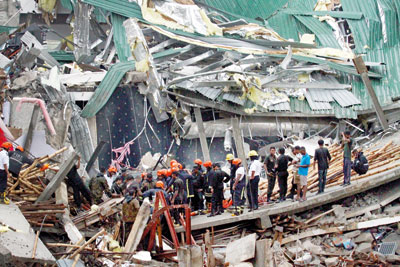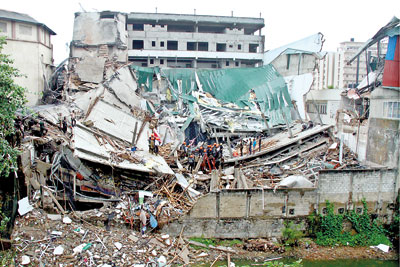News
CMC blessed the collapsed Wellawatte building twice, inquiry finds
View(s):By Chrishanthi Christopher
The authorities did not monitor or inspect the work on the Wellawatte building that collapsed, and there was no mechanism for checking the construction work, the industry regulator has found. The Colombo Municipal Council had also given blanket approval for the building — twice in the span of three years.
 Apart from that, qualified people were not involved in The Excellency project, there were no proper designs, no project managers, no planning, and the contractors were changed every now and then. These are among a long list of findings in a report by the Construction Industry Development Authority, following an investigation.
Apart from that, qualified people were not involved in The Excellency project, there were no proper designs, no project managers, no planning, and the contractors were changed every now and then. These are among a long list of findings in a report by the Construction Industry Development Authority, following an investigation.
The report also highlights the need to empower the regulator. The CIDA Act has not been gazetted. The report was handed to Housing and Construction Minister Sajith Premadasa last week. CIDA’s Director and engineer Savindra Amarasekera, said that, according to Colombo Municipal Council requirements, buildings built for recreational purposes must not exceed three floors. In 2006, the owner of ‘The Excellency’ had been granted approval to build a rectangular structure with two basement floors, the ground floor and seven floors on top.
But it had been amended into an ‘L’ shaped building. After that there had been an attempt to build an extension to the original building in the rear. The owner had not commissioned qualified people to build the extension. CIDA said there were no records of when the work started on the extension and for how long it went on. Work had been going on for sometime with intervals between. Work has been handed to different contractors.
While the original building (front portion) stood firm, it was the new structure that was being built that crumbled. Investigations reveal that the CMC had approved the first building in 2006 and given a second approval in 2009. There is no reason given for the second approval. However there had been a lapse of three years (2006 to 2009) between the approval and the completion of the building. The completed building was ‘L’ shaped instead of rectangular.
 The owner has not obtained approval for the extension that collapsed, nor had he obtained a certificate of conformity. ‘The owner was apparently trying to make it a rectangular building using the original structural approval. ‘There was only a blanket approval for a rectangular shaped building,’ Amarasekera said.
The owner has not obtained approval for the extension that collapsed, nor had he obtained a certificate of conformity. ‘The owner was apparently trying to make it a rectangular building using the original structural approval. ‘There was only a blanket approval for a rectangular shaped building,’ Amarasekera said.
According to the report, major lapses included a lack of proper designs for subsequent phases, inadequate planning and scheduling, lack of project managers, poor communications, changing of contractors from time to time, and the absence of collaboration with technical groups, coupled with improper or no monitoring mechanism from the authorities.
The two structural approvals given were by the then director of planning of the CMC. Both documents were signed by one and the same person.
Worsening the problem, the extension wing the contractors were working on was touching the water of the canal that runs behind the building. The CMC regulations require that any building running along a waterfront has to be set back 20 feet. Also, the construction should have the National Building Research Organisation approval with regard to quality of piling used and the structure of the building.
CIDA, the building regulator, requires under its act that organisations having jurisdiction over huge construction projects (CMC and the Urban Development Authority) notify it. Also CIDA Act No. 33 of 2014 insists that ethical practices be adopted in construction works of such nature using registered contractors.
The report says that the sub -contractors had admitted that qualified people had not been involved in the Wellawatte project and that instructions for steel reinforcements had come through the owner. Also, no authorities came into inspect or monitor the work. However, the CIDA Act, although it was passed on December 9, 2014, has not been gazetted. The draft bill is with the Legal Draftsman’s Office.
The act includes 20 regulations recommending the employment of qualified persons in preparation of designs – including architectural, structural, electrical, water supply and sewerage, designs – and services. Emphasis is also laid on obtaining certificates of conformity from relevant authorities for all construction projects and for work to be attended to by CIDA registered contractors.
CIDA’s web-based Construction Contractor Performance Monitoring System may be viewed to check changes to the threshold limits of project values to cover all identified construction work considering the practical limitations. The present threshold value remains at Rs 10 million.
| Bimonthly reports sought from architects All registered architects are being asked by the Colombo Municipality to submit a report on construction projects every two months under a new regulation. Commissioner V K Anura, said the report should include details of all projects they are involved with. He confirmed that the portion of the building that collapsed had not been approved by the CMC. He said that many constructions and extensions are being done to existing buildings in the city without seeking CMC approval. ‘It is not possible to know whether it is done illegally. They get hold of fake architects and extend their buildings in stages,’ he said. He said the CMC will be visiting all construction sites that seem suspicious and will take action against owners of such buildings. | |

